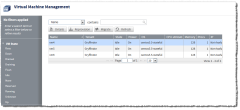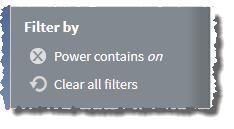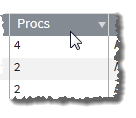Fields: Virtual Machine Management
Path: Services > VM Management
|
Image 13-2: Virtual Machine Management |

|
|
Click to enlarge |
The Virtual Machine Management page displays all the VMs in your data center. On this page, you can do the following:
- Search for, filter, and sort VMs (see Searching, sorting, and filtering VMs).
- Reprovision VMs (see Reprovisioning VMs).
- Migrate VMs to new hypervisors (see Migrating a VM).
- Drill down to see details about a specific VM (see Viewing VM details).
Lets you narrow your search to a specific field (one of Name, Tenant, Status, Power, OS, IP, or Datacenter).
Search bar (contains)
Lets you specify a term to search in the field (for example, a term that would appear in a VM name or OS). For more information, see Searching, sorting, and filtering VMs.
For example, if you wanted to see only the VMs that were powered on, you would select "Power" in the Search filter drop-down, then enter "on" in the Search bar.
You should not use the ampersand (&) character in your search.
Filter by
Displays the filters applied to the VMs that appear in the list.
If you select a value from the VM State field, the filter is noted at the top of the Filter by section. Likewise, when you search on a specific field, the field value you selected appears in the section. For example, if you search by Power and enter "on," the following appears:

To remove the filter on individual selected field values, click the remove icon ( ) next to the filter you want to remove. To remove all filters so that all VMs appear in the list, choose Clear all filters.
) next to the filter you want to remove. To remove all filters so that all VMs appear in the list, choose Clear all filters.
Tip: To save a set of filters and specific sorting order for easy reuse, bookmark the VM Management page in your browser once you finish creating your filters.
Lets you apply one of the following pre-determined state filter options to your list of VMs:
| Option | Description |
|---|---|
| Busy | Lets you apply a filter to the list that causes only the VMs in a "busy" state to display. "Busy" means that the VM is running workload and cannot accept more. |
| Down | Lets you apply a filter to the list that causes only the VMs in a "down" state to display. "Down" means that the VM is not available for workload. |
| Drained | Lets you apply a filter to the list that causes only the VMs in a "drained" state to display. "Drained" means that the VM has been sent the drain request and has no workload on it. |
| Draining | Lets you apply a filter to the list that causes only the VMs in a "draining" state to display. "Draining" means that the VM has been sent the drain request, but still has workload on it. |
| Flush | Lets you apply a filter to the list that causes only the VMs in a "flush" state to display. "Flush" means that the VM is being reprovisioned. |
| Idle | Lets you apply a filter to the list that causes only the VMs in an "idle" state to display. "Idle" means that the VM is available for workload, but is not currently running anything. |
| None | Lets you apply a filter to the list that causes only the VMs in a "none" state to display. "None" means that the VM is set to "none" by the resource manager |
| Reserved | Lets you apply a filter to the list that causes only the VMs in a "reserved" state to display. "Reserved" means that the VM is being reserved. This is an internal Moab state. |
| Running | Lets you apply a filter to the list that causes only the VMs in a "running" state to display. "Running" means that the VM is running workload and can accept more. |
| Unknown | Lets you apply a filter to the list that causes only the VMs in an "unknown" state to display. "Unknown" means that the state of the VM is unknown. |
| Up | Lets you apply a filter to the list that causes only the VMs in an "up" state to display. "Up" means that the VM is up, but the usage is being determined. |
List of VMs
Displays all your VMs within the data center. The following fields are displayed in this list:
Virtual machines are attached to tenants. You will only be able to see virtual machines attached to tenants you belong to. For more information, see About tenant management.
| Field | Description |
|---|---|
| Name | Displays the name of the VM. |
| Tenant | Displays the name of the tenant the VM is attached to. |
| State |
Displays the VM service's state—one of:
|
| Power | Displays whether the VM is powered on or off. |
| OS | Displays the current or expected operating system for the VM. |
| CPU Utilization | Displays the CPU utilization percentage on this VM. |
| Memory | Displays the amount of memory configured for the VM (in megabytes). |
| Procs | Displays the number of processors configured for the VM. |
| IP | Displays the IPv4 address for the VM. |
You can resize and reorder the columns in the table.
- To resize a column width, move your mouse to the center column border inside the column heading, then click and drag it to where you want it to display.
- To change the column order, click the column heading for the column you want to move, then drag it to where you want it to display.
You can select a VM from the list to view its details by double-clicking it. For more information, see Viewing VM details.
Sort
Lets you sort the list of VMs by a particular field. Click the field once to sort in ascending alpha-numeric order. Click the field again to sort in descending order.

For more information, see Searching, sorting, and filtering VMs.
Page
Displays which page of results you are currently viewing (for example, "Page 3 of 14"). You can navigate between pages of VMs with the following options:
- Change the number VMs that display on a page.
- Go directly to a page of results. (Specify the page number and hit the Enter button.)
- Navigate forwards and backwards through the pages one at a time.
- Navigate directly to the first or last page of results.




Reprovision
Lets you reprovision a VM (or multiple VMs). For more information, see Reprovisioning VMs.
This option is grayed out until you have selected a VM.
Migrate
Lets you migrate a VM to a new hypervisor. For more information, see Migrating a VM.
This option is grayed out until you have selected a VM.
Details
Lets you view the details of the VM you have selected from the list. You can also double-click a VM to view its details.
When you view a VM's details, one of two things will happen:
- If the VM you view is part of a service, Viewpoint will take you to the Service Details page and display the VM detail information in the Properties tab. For more information, see Fields: Service Details.
- If the VM you view is not part of a service, Viewpoint will take you to the Virtual Machine Details page and display the VM detail information. For more information, see Fields: Virtual Machine Details.
Refresh
Lets you refresh the list.
Related topics